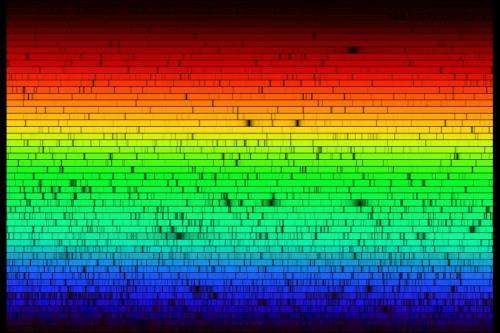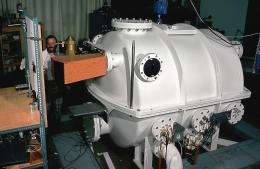Colorful solar instrument treks east for a new career

(PhysOrg.com) -- One of the world's most colorful solar instruments is moving across country for a new life dissecting the chemistry of comets and stars.
The Fourier Transform Spectrometer (FTS) recently ended its career with the National Solar Observatory (NSO) at Kitt Peak, AZ and is being shipped to Old Dominion University in Norfolk, VA, with delivery scheduled for February 9th. There it will operate under the direction of Dr. Peter Bernath, chair of the ODU Department of Chemistry and Biochemistry. He is a long-time FTS user whose work includes discovering traces of steam inside sunspots.
"The FTS is one of the premier instruments for laboratory spectroscopy, high-resolution solar spectroscopy, and other research," Bernath said. "It is a fantastic instrument."
The FTS was built in 1971-76 and used almost continuously through 2001 at NSO's McMath-Pierce Solar Telescope at Kitt Peak for solar and atmospheric physics, and as a stand-alone laboratory spectrometer. It was designed by the late Dr. James Brault, a physicist who joined NSO in the mid-1960s. Brault had a strong aptitude for instrumentation and computer programming, and applied his unique perspective and talents to what was then consdiered a radical departure from spectrograph design. Pressures on the NSO budget have made it impossible to keep operating the FTS, and other operators at Kitt Peak have expressed interest in its lab space.

Millions of people have seen one of its products, a reconstruction of the Sun's spectrum mottled with black absorption lines representing the fingerprints of atoms in the solar atmosphere. The colorful image only hints at the power of the FTS, which can measure the intensity of light in incredibly narrow slices of the spectrum from 250 nm (ultraviolet) to 18,000 nm (18 microns; far infrared). Human vision spans just 380-770 nm (violet to deep red).
The solar spectrum image came from the 1984 "Solar Flux Atlas from 296 to 1300 nm" (ultraviolet to near-infrared). This Atlas, "Atmospheric Transmission Above Kitt Peak, 0.5 to 5.5 microns" (green to mid-infrared), and other products still are used worldwide. Still more can be done with the FTS.
"I would like to use the FTS in a laboratory here at ODU to make measurements related to molecules in the atmospheres of planets, comets, and stars, as well as for undergraduate and graduate teaching" Bernath said. For example, Bernath has used the FTS to analyze an unusual cousin of cyanide, CN molecules (cyano free radical) found in many astronomical sources and in flames here on Earth. His particular interest is molecules made of rare carbon-13 or nitrogen-15 isotopes or both. The slight mass difference causes subtle changes in emissions from the more common version, shedding light on the composition, history and origin of comets, planets, and stars.
The heart of the FTS goes back to 1887 and early relativity experiments involving the speed of light by A. A. Michelson. Mechanical yardsticks won't do, so Michelson used light. Folding a beam of light back on itself forms light and dark patterns as the light waves interfere with each other. Changes along the path alter the pattern in a measurable fashion. This allows measuring the intensity of light at extremely fine fractions of a wavelength.
Such precision required special carriages that slide the FTS's optics on fine oil bearings mounted atop a polished granite table, all inside a vacuum chamber as a laser measures their ever-changing positions. The Fourier Transform part of the name refers to a sophisticated type of math used to reconstruct the spectrum from the interference pattern. While more complex than a grating that spreads light much like a CD creating the rainbow, the delicate system gave the FTS exquisite precision that made it invaluable in the history of solar physics, and should make it an asset for continued exploration of the cosmos.
NSO's mission is to advance knowledge of the Sun, both as an astronomical object and as the dominant external influence on Earth, by providing forefront observational opportunities to the research community. NSO is operated by Association of Universities for Research in Astronomy (AURA Inc.) under a cooperative agreement with the National Science Foundation (NSF) for the benefit of the astronomical community.
Provided by National Solar Observatory



















